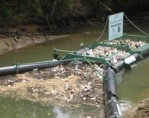The technology turns a maintenance problem at the Nansemond plant into a commercially viable fertilizer product with no additional cost to the Hampton Roads Sanitation District.
Government initiatives could bring that estimate higher, the firm suggests.
In all, 14 organizations and one individual were awarded Clean Air Excellence Awards.
The organizations say the new guidance can be used to simplify and streamline the request for proposal process.
The University of Massachusetts Amherst research team says the technique readily stores solar power with existing infrastructure.
EPA lists those hotels that have earned the Energy Star label on a government Website.
The Texas Commission on Environmental Quality says it will continue to monitor air quality in the area so that longer term data will be available to make even more informed conclusions.
The Competitive Enterprise Institute has made three Freedom of Information Act requests to which, it says, NASA has not responded.
Five lucky communities would share $800 million to deploy 700,000 electric vehicles within six years.
The Northwest Arkansas Conservation Authority will use the funds for a portion of the engineering and final design phase of a conveyance system.
The National Oceanic and Atmospheric Administration contracted C&C Technologies to conduct a magnetometer survey of a proposed alternate anchorage site near the mouth of the Mississippi River, where ships can wait until their hulls are inspected.
Gulf Chemical & Metallurgical Corporation pleaded guilty to 11 felony violations of Texas Water Code and will pay a $2.75 million fine.
Agency schedules listening sessions in June and July to get feedback on possible modifications to NPDES permits.
CH2M Hill, New-Com say the projected $240 million facility also is under budget.
Shortened schedule has state agency holding meetings before the federal standard is finalized.
Research provides insight into conditions needed to produce nitrogen fixation.

City takes out ARRA-funded loan to help stop trash from polluting the Satilla River.
Five Chinese companies manufactured the 10 drywall samples tested for CPSC and found to emit the highest levels of hydrogen sulfide.
EPA reviewed state data to find that a legally significant number of spikes did not come from regional dust storms; Arizona could lose transportation funding.